We are in Apulia, 'the heel of Italy', in the southern part of the Murge plateau, between the municipalities of Bari, Brindisi and Taranto. Here, among undulating hills, expanses of olive and almond trees, ancient farms surrounded by vineyards, orchards and dry stone walls, lies the enchanting Itria valley with its villages. This is a land of ancient traditions, authentic and with a strong bond with its natural environment, a bond also reflected in its rich local food and wine.
When you arrive in the Itria valley, you will be immersed in a unique, almost fairy-tale landscape, made up of picturesque white villages with their alleys full of colourful flowers, the famous trulli, the countryside with its infinite colours and scents, and the red land typical of the south!

The Itria Valley and its villages

The Itria Valley and its villages: Locorotondo - Ph. credit: Apulia taste of Italy - fb page
One of the elements that make the Itria Valley unique is the presence of the trulli. Infact, the valley is also called "the valley of the Trulli".
Trulli are ancient rural stone constructions characterised by a cone-shaped roof with a pinnacle often adorned with mystical and religious symbols. These ancient dwellings, found among the fields on the outskirts of villages, are now often used as simple, comfortable accommodations for tourists and give a touch of magic to the valley, creating a unique atmosphere.
According to sources, the name Itria derives from the Eastern cult of the Madonna Odegitria, imported by Basilian monks who came to Apulia from the Eastern Roman Empire in 977. The Madonna Odegitria, known as the "Madonna of the good path", showed the way to wayfarers in difficulty. It is no coincidence that the best way to get to know the Valle d'Itria is by walking or cycling through it. Walking among trulli, ancient villages and marvellous views will allow you to grasp the essence of this unique valley.
Below are the most beautiful villages in the Itria Valley. We also recommend what to do and see so you can organise a trip with plenty of experiences and emotions!
Ostuni
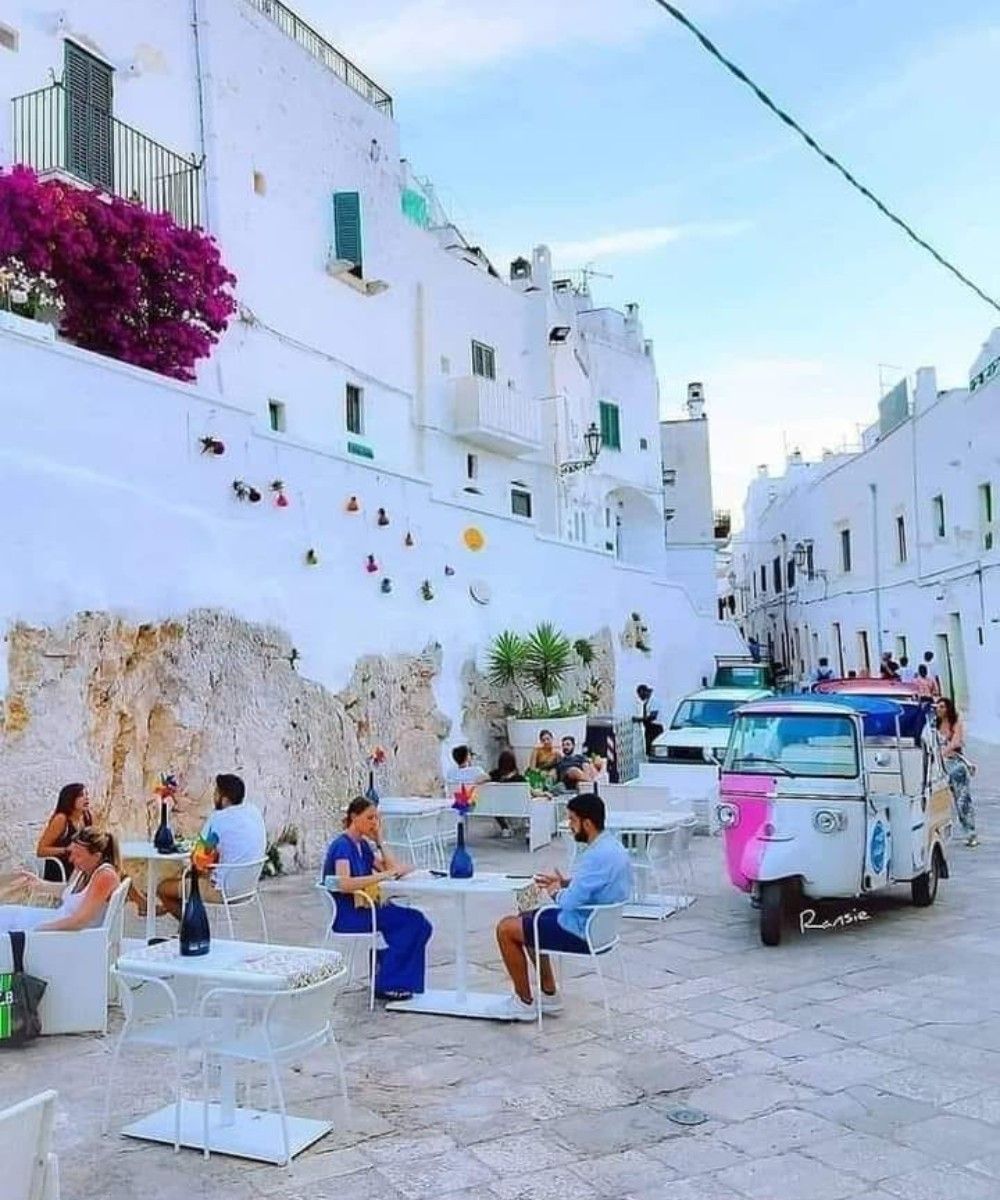
Il centro storico di Ostuni - ph. credit: Apulia taste of Italy - fb page
Ostuni is undoubtedly one of the most touristy and well-known towns in the valley. Officially, only some of its districts fall within the Itria Valley. A visit to the historical centre of the "white city" is a must.
Famous for its little white houses overlooked by the beautiful Cathedral and located only a few kilometres from the sea, it is surrounded by olive groves. In Ostuni, you can alternate cultural visits with the beautiful beaches of the Adriatic coast.
First, get lost in the narrow streets of the old town, with its little houses adorned with Baroque-style gates, plants, flowers and many typical shops and craft workshops, where you can sample local food and wine specialities.
In the upper part of the old town, you will find the Cathedral, completed in 1495 and dedicated to Santa Maria dell'Assunzione. The church, with its Gothic façade characterised by an imposing rose window, several Baroque chapels and a splendidly painted ceiling, bears witness to the religious architecture of that era.
Directly in front of the Cathedral is the famous Arco Scoppa, a stone structure that connects the Bishop's Palace with the Seminary Palace and which, due to its striking location and beauty, is a landmark in the city and the backdrop for many beautiful photographs.
Continuing your stroll through the historical centre, you will reach Piazza della Libertà, Ostuni's vital centre and meeting point. Here is the obelisk dedicated to Saint Oronzo, the town's patron saint, the church of San Francesco d'Assisi, the town hall and several bars and restaurants.
Surrounding the town are the imposing Aragonese Walls, which offer a splendid view of the whole area: in front of you are expanses of olive trees reaching as far as the sea!
In Ostuni, there is a lot of walking to be done. If you don't feel like it, you can take a tour on board an "ape calessino"... and to end your day on a high note, treat yourself to an aperitif with a view of the sunset in one of the many bars in the historic centre!
Ostuni is also synonymous with the sea; indeed, in the summer season, it is an ideal destination for those who also wish to relax by the sea. Marina di Ostuni, Torre Pozzelle and Torre Guaceto are just some of the splendid sandy and rocky beaches at your disposal.
Throughout the summer season, the municipality of Ostuni organises a bus service that connects the historic centre to the beaches of Ostuni Marina.
The city of Ostuni can be easily reached by train from the main Apulian cities on the Adriatic coast (Bari, Brindisi and Lecce) The railway station is only a few kilometres from the historic centre, which can be easily reached by bus.
The nearest airport is Brindisi-Casale, in the municipality of Brindisi.
Cisternino
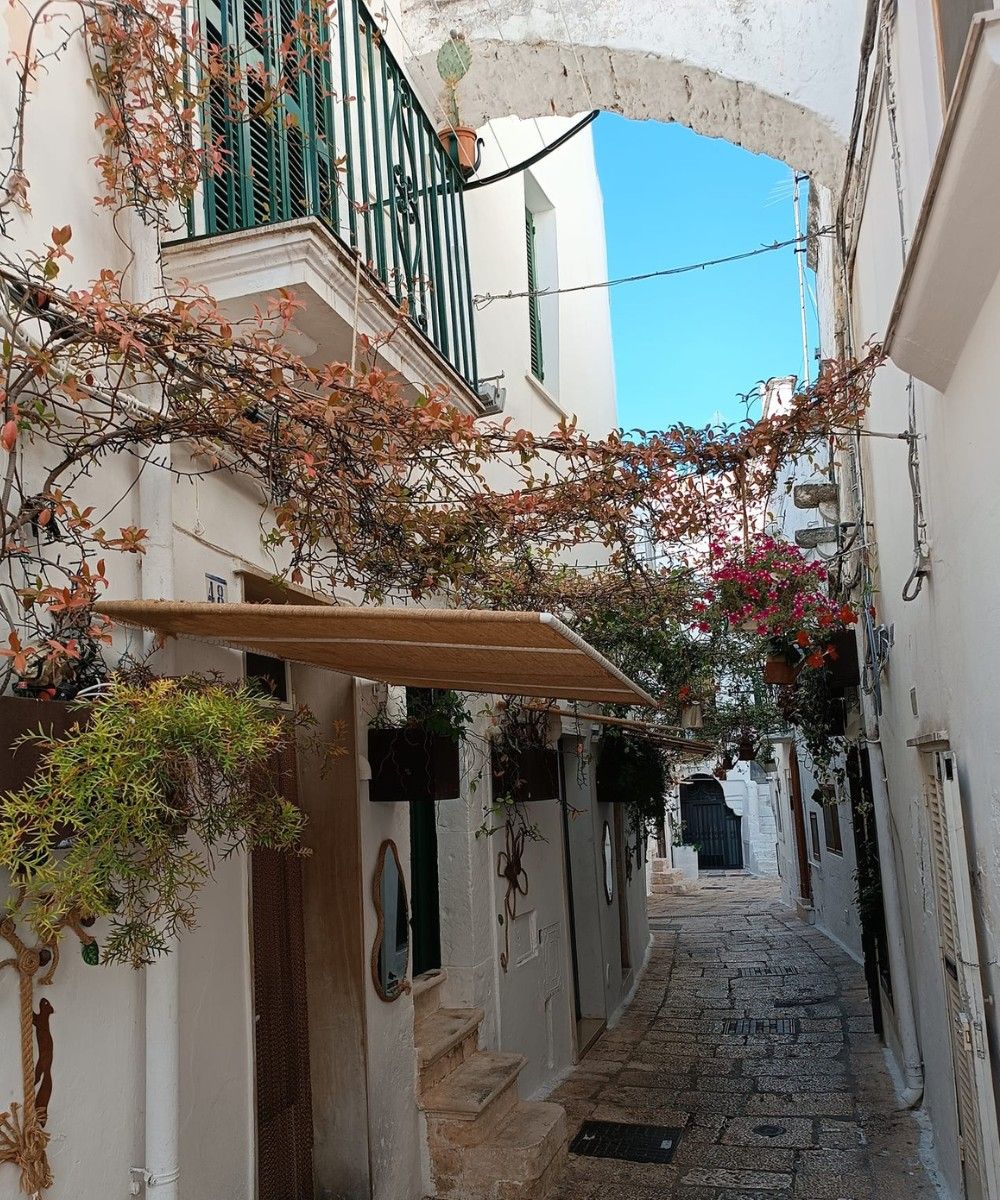
The historical centre of Cisternino - Itria valley - ph: credit: Chiara Persico
Less well-known than the famous Ostuni and Alberobello, Cisternino will be a pleasant surprise!
This small village, surrounded by centuries-old olive trees and trulli, welcomes us into its labyrinth of alleys, white steps and small squares coloured by many flowers.
The historic centre is small and can be visited easily in a day. The walk can start from Piazza Garibaldi, where on one side you will find the Villa Comunale and on the other a Norman-Swabian Tower, the Porta Grande and the mother church dedicated to St Nicholas.
The church of San Nicola is the largest and most important church in Cisternino. Inside, you can admire a beautiful Apulian Renaissance sculpture: the Madonna with Child and Offerers, also known as the "Madonna del Cardellino".
From Piazza Garibaldi, you will also have a splendid view of the Itria Valley, with its trulli and bucholic landscape.
Getting lost in the narrow streets of the centre, you will find yourself in the small and lively Piazza Vittorio Emanuele, overlooked by the neoclassical Clock Tower.
All around are craft shops, ice cream parlours and bars. This is a meeting point for tourists and locals alike, relaxing with an aperitif or enjoying a good ice cream.
In Cisternino, all you have to do is walk and get lost in the alleys and small squares, admiring the typical white houses, one leaning against the other, with balconies and stairs full of colourful flowers. You will also happen to read phrases of famous people on the walls of the houses or find beautiful swings here and there!
Cisternino is undoubtedly one of the most characteristic and evocative villages of the Itria Valley; in fact, it has also been included in the list of the most beautiful villages in Italy.
And to round off your day in the best way possible, look for a typical trattoria or a butcher's shop with a braceria and try the famous "bombette", delicious meat rolls of Cisternino.
Cisternino can be reached by car via the SS 16, by train via the local railway Sud-Est (F.S.E.) and by bus via local lines.
The most beautiful villages in the Itria Valley: Locorotondo
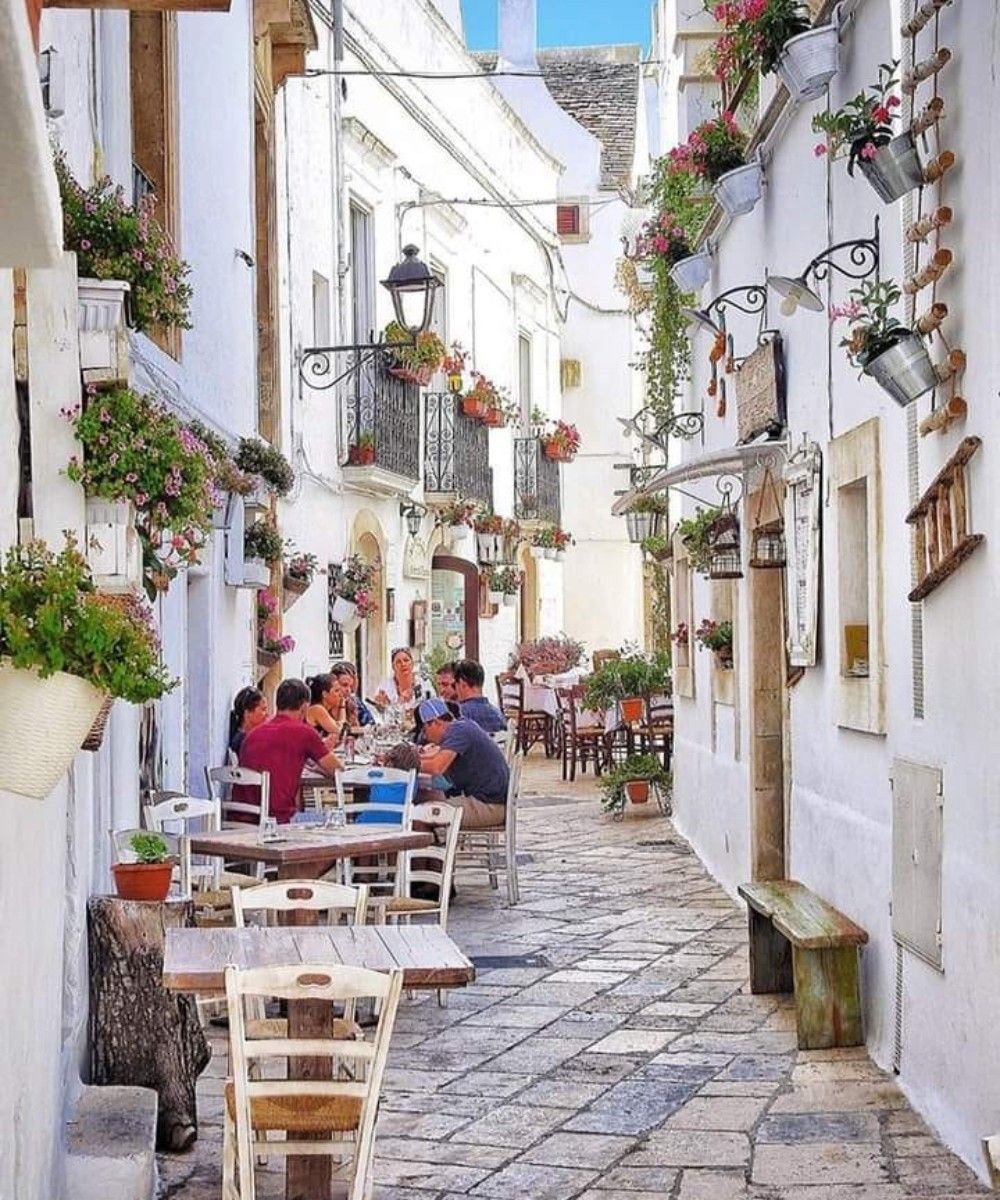
The alleys of Locorotondo - Itria valley - ph: credit: Apulia taste of Italy - fb page
The village of Locorotondo will appear at the top of a small hill. It will amaze you with its beauty and peculiar circular shape from which it derives its name: round place, Locus Rotundus in Latin.
Locorotondo is the village of the ''cummerse'', typical rectangular houses with sloping roofs, which you can admire walking through the white alleys of the old town, among low houses and flowered balconies, medieval towers, ancient churches and palaces. The village is a small open-air museum where you can admire traditional Apulian architecture.
In the historical centre, you find the main sights. The Mother Church of San Giorgio, dating back to the 14th century, the small church of San Nicola simple and elegant, the church Madonna della Greca, the oldest in Locorotondo, and the 18th-century clock tower.
Near the municipal library, you will find Palazzo Morelli, the most important example of Baroque architecture in Locorotondo. Of the architecture of this palace, the entrance portal stands out, surrounded by a stone archway embellished with scrolls and acanthus leaves, with the noble coat of arms of the Morelli family in the centre.
Another noteworthy building is the Palazzo del Barone De Simone. This is a 17th-century noble palace that houses a museum with works of art and archaeological finds.
To end your walk on a high note, head to the Parco della Rimembranza at the foot of the village. Here, you can relax while admiring a beautiful panoramic view of the Itria valley.
Locorotondo, like Cisternino, is a village of a magical atmosphere where you can immerse yourself in the most authentic Apulia.
The village can be reached by car from the main Apulian cities via the Trulli state road. By train, the local railway Sud-Est (F.S.E.) stops at the Locorotondo station.
Alberobello: the most famous village in the Itria Valley
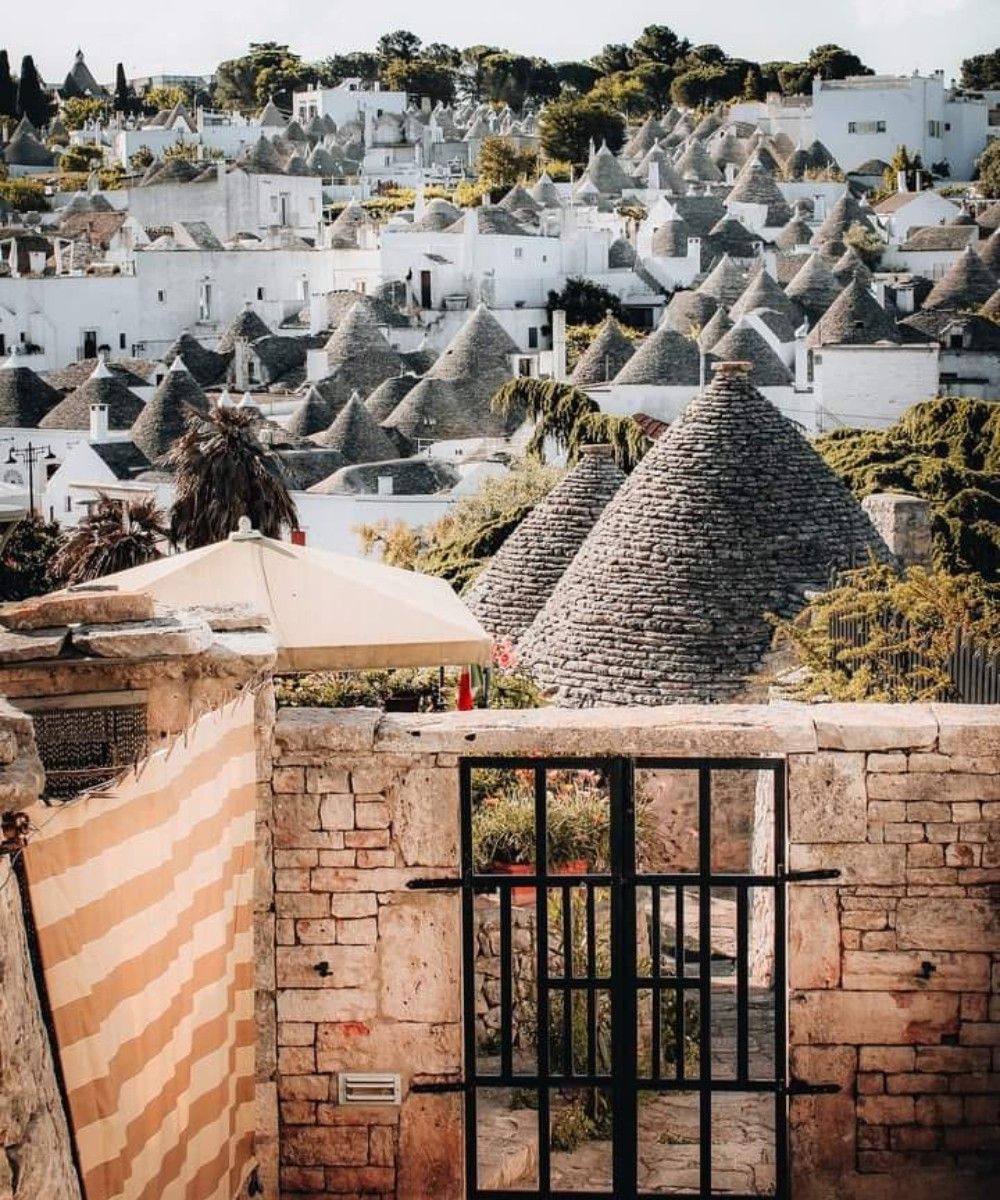
Alberobello - skyline - ph. credit: Apulia taste of Italy - fb page
Of all the villages in the Itria Valley, Alberobello is undoubtedly the most famous. It owes its fame precisely to the Trulli, ancient conical-shaped stone constructions, which, due to their uniqueness, have been part of the UNESCO World Heritage List since 1996.
Trulli can be found all over the Itria Valley. The highest number of best-preserved trulli is located in Alberobello. This is why the town has been nicknamed the "capital of Trulli".
The historical centre of Alberobello is divided into two districts: the Monti district and the Aia Piccola district.
Walking through the Monti district, you will find the most characteristic and ancient trulli, including the Trullo Sovrano, a two-storey trullo turned into a museum of traditional arts and crafts.
Aia Piccola is a smaller district with modern trulli, often inhabited by locals, shops, small restaurants and craft workshops.
Also worth seeing are the Parish Church of St. Anthony of Padua, a 17th-century trullo church, the Church of Saints Cosmas and Damian, an 18th-century Baroque church and the
museum "Casa Pezzolla", dedicated to the culture and territory of Alberobello.
Finally, don't forget to climb the Belvedere Santa Lucia for a nice photo and a panoramic view of Alberobello and its Trulli.
Alberobello is a fascinating town with a unique and evocative panorama.
You can reach the town of the trulli by car, bus and train (Bari-Taranto line).
Book a tour of AlberobelloMartina Franca
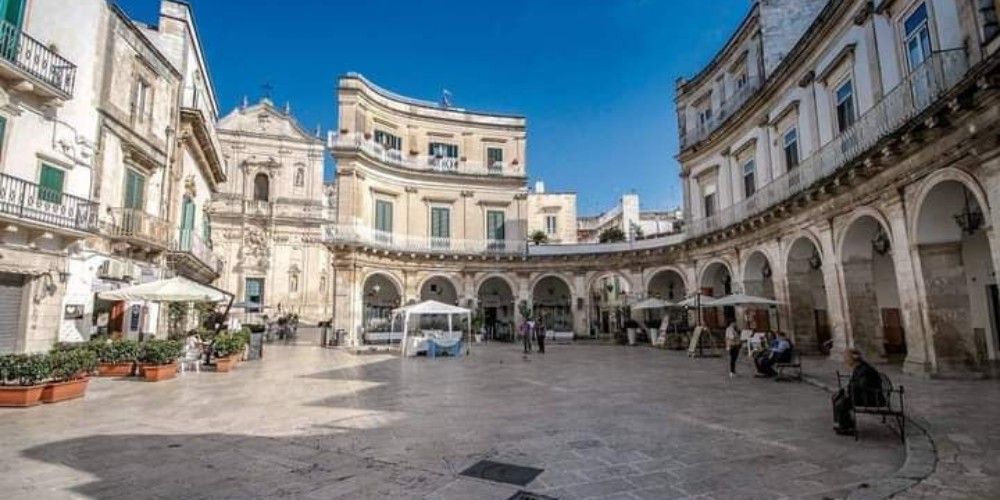
Martina Franca - Itria valley: central square ph. credit: infopint Martina Franca fb. page
Martina Franca, also known as the pearl of the Itria Valley, is a 14th-century founded city in the middle of the Itria Valley. Its charming historical centre rises on a hill about 400 metres above sea level, offering stunning views over the entire valley.
The historical centre is an intricate set of alleys, small squares, elegant noble palaces, monuments and churches in the "Martinese Baroque" style, a particular architectural style that developed in the 18th century, a period of high development for the town.
You can start your visit from the central Piazza del Plebiscito, where you will find the Basilica di San Martino, dedicated to Martin, the city's patron saint. The building, built in Martino's Baroque style, houses the relics of St Comasia and St Martina and beautiful paintings by Domenico Antonio Carella.
Not to be missed is a visit to the Ducal Palace in Piazza Roma. This building, now the Town Hall, is an example of Martina Baroque enriched with Renaissance elements. Inside, you can admire beautiful frescoed rooms, particularly the Arcadia, Myth and Bible rooms, finely decorated by Domenico Carella in 1176.
As you stroll, you will encounter other fine cultural attractions like Palazzo Nardelli and Palazzo Stabile, the Church of San Francesco d'Assisi and the Church of Santa Maria delle Grazie.
Culture lovers will find many entertaining activities and events in Martina Franca. Among the most famous is the Festival della Valle d'Itria, an opera and bel canto festival that for more than 40 years has been held between July and August in the atrium of the Palazzo Ducale and other places in the city.
There are also many tastings of local products, first and foremost Martina Franca Doc wine and the tasty capocollo, a salami made from the meat of pigs raised in the woods surrounding the city.
At the end of the day, treat yourself to a good aperitif in a bar in the centre, watching elderly chatting in front of the doors and enjoying the "baroque" atmosphere and views of Martina Franca.
Martina Franca is easily reached by car from the main Apulian cities via the Trulli state road (ss 172) and by bus via FlixBus bus lines and local buses.
The villages of the Itria Valley: Ceglie Messapica
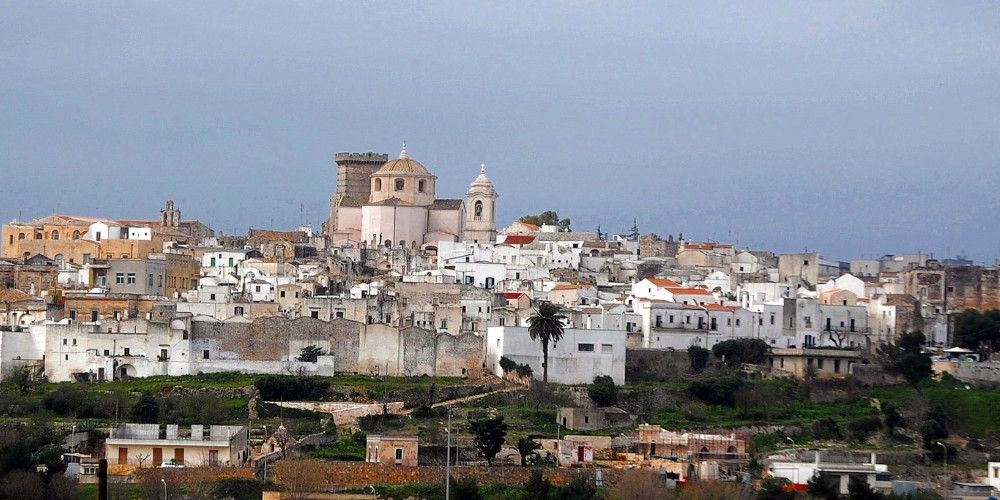
The village of Ceglie Messapica - Itria valley - ph. credit: wikipedia
Nestled between trulli and olive groves, Ceglie Messapica is located in the southernmost part of the Itria Valley, on the border with Salento.
It is one of the oldest towns in Apulia and, according to sources, was founded by the ancient tribe of Messapi that lived in what is now the Salento region in classical times.
The Messapi have been attributed to the many typical stone buildings called specchie, probably used as watchtowers to defend the town.
In the Ceglie area, you can visit several archaeological sites with specchie, necropolis and karstic caves dating back to the Messapi period.
Among the most interesting are the Grotte di Montevicoli, which can be visited along a path through stalactites, stalagmites, columns and large pools of water, and the Grotta di San Michele, a karstic cavity once frequented by monks.
In this cave, you can admire a stone altar and three frescoes depicting the Praying Madonna, Christ Pantocrator and St Michael Archangel.
A pleasant walk through the medieval centre of Ceglie will allow you to admire buildings of historical and architectural value.
Stop at the beautiful Piazza del Plebiscito and photograph the Clock Tower. Visit the Ducal Castle, a symbol of the town, and from its high spot, admire the panorama of the village and the valley.
There is no shortage of fine religious buildings, first and foremost the Chiesa Madre di Ceglie Messapica or Collegiata di Santa Maria Assunta, the town's most important place of worship, which houses numerous frescoes and works of art ranging from the 16th to the 18th century.
Other churches include the Sanctuary of San Rocco, from the 16th century, and the Rural Church of the Madonna della Grotta, in Gothic style, dating back to the 9th century after Christ.
A must-try are the typical dishes of the local cuisine, a home-made cuisine linked to the products of the land.
Ask the locals to recommend a good trattoria and try "stacchiodde" and "strascinati", the typical home-made pasta served with a simple tomato sauce or with a ragout of horse chops and grated pecorino cheese or turnip tops.
Ceglie Messapica can be reached by car from Brindisi via the SS7 and SP26. By bus via local buses from Brindisi and Taranto and by train with direct connections from Taranto (Ferrovie del Sud Est).
Itria Valley: between picturesque villages and natural beauty
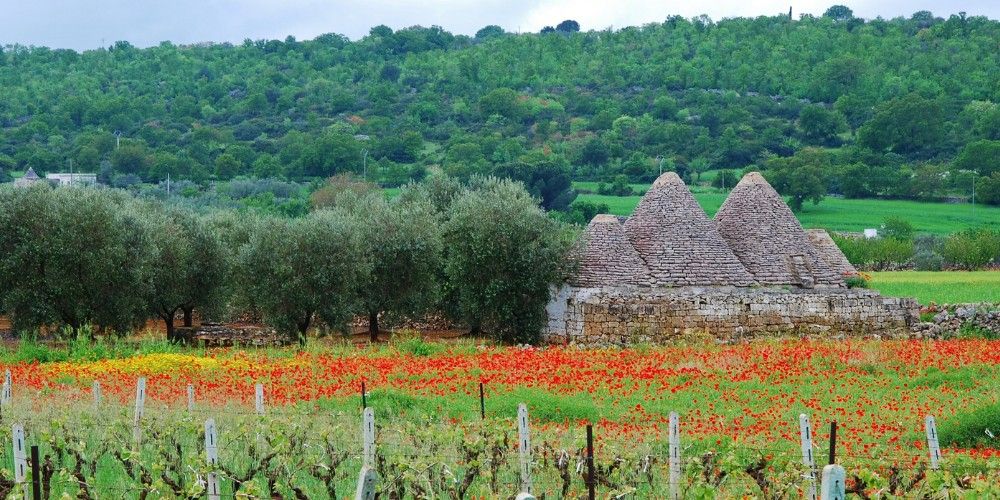
Itria valley: nature - ph. credit: Jennifer Deacon-unsplash
If the villages of the Itria Valley amaze you with their beauty, the landscape around them will impress you even more! Lush forests with monumental trees, spectacular caves, hills with olive groves, orchards, dry stone walls, trulli and good food.
The Itria Valley is ideal for a 'slow' journey in which you discover, appreciate and capture the essence of its territory!
Puglia is crisscrossed by pedestrian and bicycle routes that allow you to visit the countless historical and cultural sites of this beautiful region, immersing yourself in its nature rich in flavours, colours and scents.
Walk lovers can take the variant Hellenic Way (via degli Ulivi) a route of 6 stages that leads from Brindisi to Alberobello, passing through the main villages of the Itria Valley.
Once in Alberobello, it is possible to continue the journey along the Hellenic route (land of the ravines). This route, whose first stop is Martina Franca, leads in 9 stages to Matera, the city of stones, a Unesco heritage site since 1993.
These two routes are signposted. GPS tracks are available for each stage.
The Itria Valley is also crossed by the Apulian Aqueduct cycle and footpath.
The Apulian Aqueduct, a great work from the early 20th century, offers one of the most beautiful routes in the Itria Valley, built on the walkways of the Main Canal of the great Aqueduct.
The trail from Ostuni leads to Martina Franca by walking or cycling among fragno oaks, olive trees, vineyards, trulli and typical Mediterranean flora.
There is no shortage of woods and nature reserves.
Around Alberobello, you can walk along the Bosco Selva trails, the forest that once covered a large part of this area. Here are mainly oaks, holm oaks and fragno oaks.
In the surroundings of Martina Franca, we find the Murge Orientali Nature Reserve. Here, for several kilometres, you can walk in silence among oak woods and Mediterranean scrub.
Continuing, you reach the Bosco delle Pianelle, one of the most extensive forests in Apulia, which develops inside a large karstic dolina.
Here are some of the most beautiful large holm oaks in Italy. In these natural areas, you can also see the donkey of Martina Franca and the Murgese horse, breeds specific to this area.
Read also our article about the 4 seasons in Itria Valley!
About the author
Written on 13/11/2023

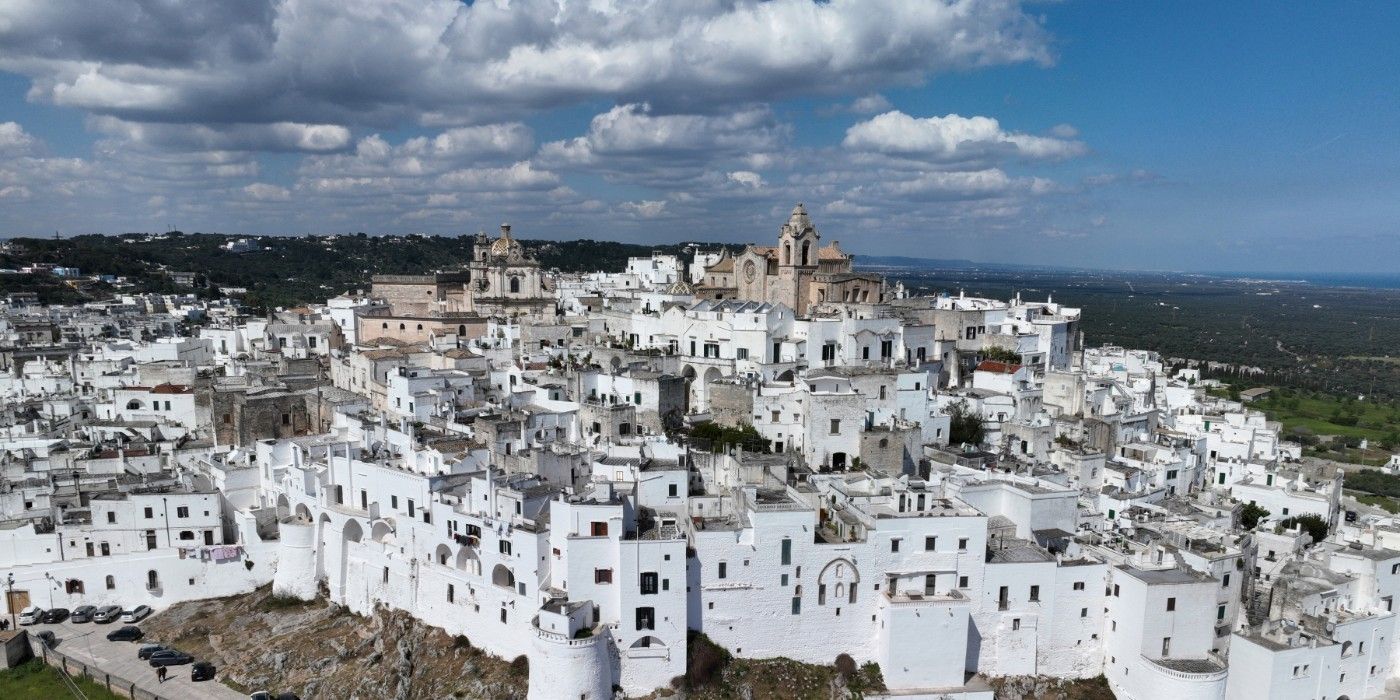

Ilaria Capatti
A journey through the most beautiful villages in the Itria Valley and its beauties.